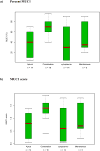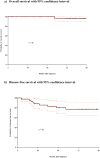MUC1 is expressed at high frequency in early-stage basal-like triple-negative breast cancer
- PMID: 23845471
- PMCID: PMC4167755
- DOI: 10.1016/j.humpath.2013.04.010
MUC1 is expressed at high frequency in early-stage basal-like triple-negative breast cancer
Abstract
Triple-negative breast cancer comprises 10% to 15% of newly diagnosed breast cancer and lacks expression of the estrogen, progesterone, and human epidermal growth factor receptor 2/neu receptors. Many such tumors are basal like, a molecular intrinsic subtype of breast cancer associated with poor clinical outcomes. Patients with early-stage basal-like triple-negative breast cancer are at a high risk for relapse and may, therefore, benefit from novel therapies, including immunotherapy. MUC1 is a tumor antigen expressed on adenocarcinomas and represents an ideal target for MUC1-based vaccination. We evaluated 52 cases of early-stage basal-like triple-negative breast cancer for MUC1 expression by immunohistochemistry. The intensity of staining was graded according to the intensity (negative [0], positive [1], or strongly positive [2]) and percentage (0%-100%) of tumor cells staining for MUC1. An overall score of 0 to 2.0 was calculated for each case by multiplying the intensity of staining by the percentage of tumor cells staining positively. Four staining patterns for MUC1 were identified: apical, cytoplasmic, membranous, and combination. Of the 52 cases of basal-like triple-negative breast cancers, 49 (94%) were positive for MUC1 expression. The mean score was 0.90 (range, 0-1.9). Cases were evenly distributed over this range, where most (67%) exhibited moderate to strong MUC1 expression (score, 0.5-1.90), 27% demonstrated weak MUC1 expression, and 6% lacked MUC1 expression. There was a significant difference in MUC1 score and percent MUC1+ cells in favor of the combination pattern. This study indicates that a large proportion of early-stage basal-like triple-negative breast cancer expresses MUC1 and provides a rationale for MUC1-based immunotherapy in this high-risk patient cohort.
Keywords: Basal-like; Mucin; Triple-negative breast cancer.
Copyright © 2013 Elsevier Inc. All rights reserved.
Conflict of interest statement
Disclosure/Conflict of Interest: None
Figures






References
-
- American Cancer Society. What are the key statistics about breast cancer? 2013 http://www.cancer.org/cancer/breastcancer/detailedguide/breast-cancer-ke....
-
- Perou CM, Sorlie T, Eisen MB, et al. Molecular portraits of human breast tumours. Nature. 2000;406:747–752. - PubMed
-
- Rakha EA, El-Sayed ME, Green AR, et al. Prognostic markers in triple-negative breast cancer. Cancer. 2007;109:25–32. - PubMed
Publication types
MeSH terms
Substances
Grants and funding
LinkOut - more resources
Full Text Sources
Other Literature Sources
Medical
Research Materials
Miscellaneous

